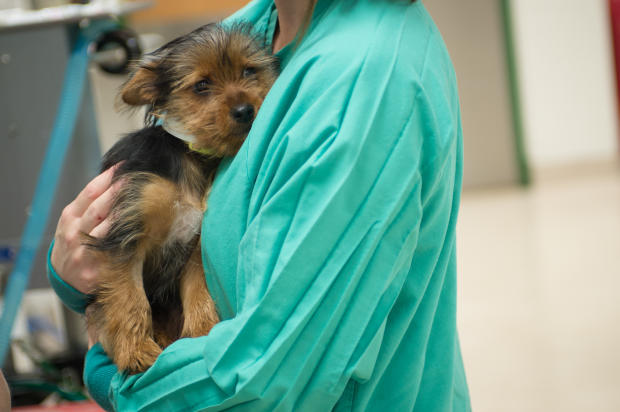Dogs with cleft palates get help from human surgery
When Dr. Bryden Stanley, a veterinarian, saw Mr. Moo, a 9-month-old dog with a cleft palate, for the first time, she wasn't sure how she was going to treat him.
The head of surgery for small animals at the Michigan State University's College of Veterinary Medicine, Stanley specializes in soft tissue surgery for animals, but there was something unique about this mixed-breed puppy: he had absolutely no soft palate.
She consulted with Dr. John Girotto, a pediatric plastic surgeon at Helen DeVos Children's Hospital in Grand Rapids, Michigan, who specializes in treating cleft palates in children, and a new partnership between human and veterinary medicine was born. Together they decided to utilize new techniques recently developed at the children's hospital for repairing and lengthening soft palates to treat Mr. Moo.
"This technique was ideal for Mr. Moo's almost complete absence of a soft palate and we believe it was the first time it was done in a dog," Stanley said.
Another dog named Louie, pictured below, underwent a similar procedure.
According to the Centers for Disease Control and Prevention, each year in the United States, about 2,650 babies are born with a cleft palate and 4,440 are born with a cleft lip, with or without a cleft palate. A cleft lip happens if the tissue that makes up the lip does not join completely before birth, resulting in an opening in the upper lip. A cleft palate occurs if the tissue that makes up the roof of the mouth does not join together completely during pregnancy.
The most common type of birth defect in the country, these conditions can lead to a number of health problems. "It impacts your ability to speak, your ability to eat, how your teeth all come in, and it will impact your facial growth over the long-term," Girotto said.
In dogs, cleft palates and lips make it difficult -- sometimes nearly impossible -- for them to eat on their own, and can lead to infections, as anything passing through their mouths can enter the sinuses and nasal passages. Many dogs born with cleft lips are euthanized by breeders, Stanley said, though she treats a number of dogs with the condition.
It is very unusual, however, for dogs to be born with absolutely no soft palate, presenting a bigger challenge for Mr. Moo. But the operation, which took place in May, was deemed a success. According to Stanley, he is now doing very well.
The doctors hope to perform the procedure in more dogs and say their experience working with canines can also help human patients. Since dogs grow at a much faster rate than humans, it's possible to learn more quickly how the surgery affects them as they develop.
"Children grow over 18 to 20 years, and the dogs that we get to interact with will grow much faster, in the order of maybe two years. That gives us a really neat opportunity to examine the growth potential for children," Girotto said. "We can get really good studies on facial growth in an animal and we can then extrapolate those results to how kids do with our surgical techniques."
Furthermore, the doctors are working to train dogs that have undergone cleft palate surgery to be therapy dogs for children who have had the same procedures. "We want the kids with clefts and the puppies with clefts to get together and understand just how gorgeous they all are," Stanley said. Both Mr. Moo and Louie's owners are eager to have their dogs work with children in this capacity, she said.
"Kids are worried about how the surgeries are going to go and what they're going to look like, and so are their parents," Girotto said. "And to be able to bring in a therapy animal that's had a cleft palate repair just like you, and for the kids to see that everything's fine and great and to be able to interact with that post-surgical dog as a therapy animal is really going to be a powerful message."
Editor's note: This story has been updated to identify the dog in the photos as Louie.




